What do you do if you want to build a pipeline to move 300 million barrels of oil but an “uncontacted” tribe is in the way? Employing consultants who claim they don’t exist certainly helps.
On July 22, Peru’s Energy Ministry gave the green light to Anglo-French company Perenco to build a pipeline in a remote part of the Peruvian Amazon that was described by one US scientist as, “the most biodiverse area in South America.” Perenco is operating in an area between the Napo and Tigre rivers known as Lot 67, the first oil concession created in that region and initially licensed to US-based Advantage Resources in 1995.
Earlier in 1995, to the southwest of Lot 67, Peru went to war with Ecuador in a dispute over their borders. The fighting was once described by Bill Clinton as, “the longest running source of armed international conflict in the Western Hemisphere.” It dated back to independence in the 19th century, but the stakes had been raised by the prospect of valuable natural resources below the soil. During the conflict in the 1990’s, Peruvian troops at one military post in the Napo-Tigre region refused to patrol in small groups. Scared of the Ecuadorians? Actually, it was the no contactados they were scared of: indigenous people who lived without regular contact with outsiders. Some years later, in 2002, two Peruvian soldiers glimpsed two of these no contactados – or “calatos” (naked people), as they’re sometimes called – and were so alarmed that they bolted, lost their bearings and spent the next 13 days wandering about the rainforest until rescued by colleagues.[1]
The soldiers aren’t the only ones to have seen or found evidence of the no contactados in this region. Local indigenous people and mestizos, loggers, fishermen, anthropologists – all have stories to tell.[2]
Numerous Peruvian government institutions have acknowledged the no contactados in this region too, including the Energy Ministry, [3] Health Ministry, the Natural Resources Institute,[4] the Indigenous Affairs Institute (INDEPA) and the national ombudsman.[5] “It has been proven that isolated indigenous people live in this zone,” INDEPA stated in a letter to the Energy Ministry in 2007.[6]
Even Ecuador’s government has followed suit, with a promise to allocate $38,000 to fund a “bi-national” plan to protect the no contactados in this region.[7] Indeed, Ecuador’s famous “Yasuni-ITT initiative” to forgo exploiting millions of barrels of oil in rainforest inhabited by no contactados in return for billions of dollars in compensation is so close to Lot 67 and Lot 39 – which was created in 1999 and surrounds Lot 67 – that some no contactados, not recognizing national borders, appear to move between both regions – that is, between an area one government has said it is willing to protect and another where the government intends to do the exact opposite.
At first, the oil companies seemed to agree. In 2003, Spanish multinational Repsol-YPF, operating in Lot 39, held a public workshop titled, “The no contactados” during which, according to a record of the meeting signed by a Repsol-YPF representative, the company agreed to prepare a response plan in case its workers made contact with the no contactados.[8] One subsequent plan was submitted to the Energy Ministry and listed a series of recommendations – some bizarre, others dangerous – to its workers. They included: 1) “Use a megaphone to inform the natives in the local languages why we are there and that it is not the company’s intention to interfere with their activities” and 2) “Explain to them their vulnerability to Western diseases and the risk they run of getting ill and infecting others in their group which could kill them.”[9]
Likewise, Barrett Resources, which had taken over Lot 67, acknowledged the existence of the no contactados and recommended megaphones to communicate with them, [10] a move slammed by Peru’s national indigenous organization, the Interethnic Association of Development of the Peruvian Rainforest (known by its Spanish acronym, AIDESEP), as “farcical.”
“Workers will probably come across these uncontacted people,” Barrett admitted in its Environmental Impact Assessment (EIA), [11] after announcing, in late 2006, that the oil deposits in Lot 67 were commercially viable and Peru’s president, Alan Garcia, had paid a visit to the site to celebrate.[12]
But then things changed – dramatically. AIDESEP had long opposed the companies’ operations by demanding this region should be made off limits and turned into a reserve,[13] and now it stepped up its opposition by filing a lawsuit against the companies, appealing to the Inter-American Commission on Human Rights and making increasingly frequent public statements. International organizations joined the fray, too. Survival International, where I worked at the time, launched a high-profile media campaign in 2007, while US-based Amazon Watch and Save America’s Forests issued the starkest possible warning to Anglo-French company Perenco when, in early 2008, it announced it had taken over Barrett and Lot 67: “You are Inheriting a Potential Disaster in Peru.“
What was all the fuss about? First, that under international agreements and norms such as the International Labor Organization’s Convention 169 or the United Nation’s (UN) Declaration on the Rights of Indigenous Peoples, neither Perenco nor Repsol-YPF has the right to operate in Lot 67 or Lot 39. Second, as Repsol acknowledged in its response plan, the no contactados, because of their lack of immunity to outsiders’ diseases, could be decimated by contact with any oil company employee – or, indeed, any outsider.
The companies responded by doing U-turns: they started to cast doubt on the no contactados‘ existence, or to deny it outright. Perenco estimates at least 300 million barrels of oil, worth about $35 billion at current prices, lie in the Napo-Tigre region, and Repsol-YPF, partnered by ConocoPhillips until recently, will be hoping large deposits lie in Lot 39, too. With that kind of money at stake, neither company wants any “naked people” in the way.
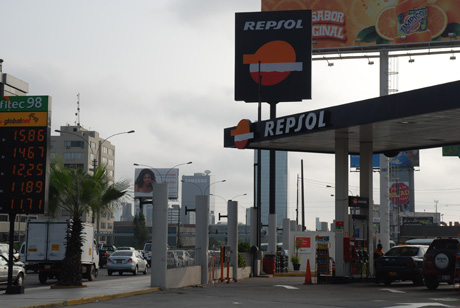
Repsol-YPF petrol station. (Photo: David Hill)
Perenco justifies its claims by citing a 137-page report by an environmental consultancy, Daimi, a participant in the UN’s Global Compact, a business initiative supposedly aimed at curbing human rights and environmental abuses. This report, paid for by Perenco, was based on research done by various teams sent into the region by Daimi, including archaeologists, anthropologists, historians, linguists, and biologists, and claims that, “nothing happened and there was no sign of any anthropological character” to suggest there were no contactados in Lot 67.
“No information exists that demonstrates or suggests the existence of isolated indigenous people in the area under investigation,” stated Daimi’s report, dated September 2008. “Given the lack of proof or traces, it has not been possible to confirm their existence.”
But how reliable was Daimi’s report, given that Perenco funded it? And what about all the evidence that had been collected in the past?
When AIDESEP proposed a reserve in this region for the no contactados, it had interviewed scores of local people and produced its own weighty report listing all kinds of evidence for no contactados‘ existence: sightings, gardens, meat remains, shelters, paths, footprints and even crossed spears.[14 ] The local group Organization of Indigenous Peoples of the East (known by its Spanish acronym, ORPIO) followed this up with its own report in 2009, including 23 sworn legal testimonies from local people.[15] It was this sort of material that has permitted so many different individuals and organizations, over the years, to acknowledge the no contactados in this region: not just government institutions like the Energy and Health Ministries, but a long, long list of NGOs and others, including Survival, Amazon Watch, Save America’s Forests, The Field Museum,[16] Intermón Oxfam, Rettet den Regenwald, Rainforest Action Network, Acción Ecológica, Forest Peoples Programme, the International Federation for Human Rights, and representatives from the Environmental Defense Fund, EarthRights International, and the Centre for International Environmental Law.
Her team made two expeditions to Lot 67 (in addition, she made another one all by herself), which resulted in the confirmation of traces of tribes. This finding was obviously included in the final overall report delivered to Perenco. Soon after, she found out (someone within Perenco told her) that her part, that is, the chapter in which was explained the finding of traces, was completely deleted from the final report. Even her pictures with objects, and proofs of the traces, as well as other evidence were deleted. Who did this? She says the advisory team of Perenco.
“Yes. Yes I do.” She hesitated once more, then it came out. “There is no doubt in my mind that there are uncontacted groups there.” She had documented evidence, especially pathways. “But it was all edited out. I was really upset when I saw the final report. It didn’t lie, the language was technically correct, but it did not reflect my view or that of many colleagues.”
Carroll also spoke to Lino Noriega, described as a forestry engineer who had visited Lot 67 on several occasions. Noriega said: “There were a lot of irregularities in the reports. Besides playing down the damage to vegetation and wildlife, they said there were no uncontacted groups. But there were footprints, signs of dwellings … Perenco got everything it wanted.”
But when the article was published, the claims had been toned down. Noriega’s “There were a lot of irregularities in the reports. Besides playing down the damage to vegetation and wildlife. . . Perenco got everything it wanted” was removed, and so too was Grandez’s “But they (Daimi) wanted to show that there aren’t any (no contactados).”
Why such changes? Perenco’s lawyers had been getting heavy, that was why. On Friday July 3, less than 24 hours before publication, general counsel Roland Fox had sent an urgent email and fax to The Guardian, saying he was aware of its intention to publish an article about Perenco:
Perenco Peru to date has read with increasing disquiet several completely false allegations made against it. We have taken the view that to take action against the writers of such internet articles is pointless, particularly as we consider that most objective observers would give little credence to their unsubstantiated allegations. However, if a newspaper with the standing and credibility of The Guardian were to repeat these allegations, either directly itself or by quoting those who have made the allegations, we would take a different stance, as we are determined to protect our reputation. I would therefore suggest that a very careful legal review is made of this article.
I continued trying to contact Montoya but still didn’t hear back. Later that year, I gave her name to two Belgian researchers, Marijke Deleu and Thomas Quirynen, who met her twice in Iquitos and whom she told – like Fisher, like Carroll – that she thought there were no contactados in Lot 67:
She says the area of Perenco is used as a corridor for uncontacted tribes that move back and forward across the border with Ecuador. She doesn’t want to make any statements … She told us the stuff DAIMI deleted is history of population in the region (and) photos of paths and testimonies. When we told her about ORPIO, she said she was going to contact them … She clearly wanted to show off a little, saying she had sooooo many more testimonies (than ORPIO)…. She said she was invited by Perenco to talk about the case (and was received by someone pretty high up, I think, I think she mentioned it was a French guy). And this guy was really interested in her work and claimed Perenco never received any of her work from Daimi….
Earlier this year, I flew to Peru hoping to meet Montoya myself. What exactly did her evidence consist of, and would she share it with me? On my first day in Iquitos, by complete coincidence, a public meeting about the no contactados was held at the National Institute of Culture. The meeting’s stated aim was to find ways to protect Peru’s no contactados, numbering an estimated 15 groups in total, and it had been convened by the Peruvian Amazon’s Investigation Institute (IIAP) together with INDEPA. The chairperson? None other than Virginia Montoya, now working as the head of IIAP’s sociodiversity program.
No mention was made of either Lot 67 or Lot 39, although at one point Montoya said, tellingly, that regions should be made off limits even if only one “uncontacted” person was thought to live there. After the meeting, I introduced myself to Montoya, who said she would be “delighted” to talk and suggested ringing her office on Monday to fix a time. When I called I was told she was traveling and wouldn’t be back for several days.
In the meantime, I went upriver to get as close to the action as I could. This wasn’t easy: a rapido speedboat from Iquitos to a tiny port downstream, a five minute mototaxi ride on a concrete strip through the rainforest, another rapido for four hours up the Napo river to Santa Clotilde, the town where Repsol-YPF had admitted the existence of the no contactados in 2003, and then, after two nights there, I hitched a lift with a logger, whom I’ll call “O,” going in the same direction. O’s boat was a battered old speedboat with no roof, no protection from the sun or the rain. Just me, O, and two workers of his. We left Santa Clotilde after lunch, spent the night at a Kichwa village, and arrived at an indigenous-cum-mestizo village, Buena Vista, one of the remotest in the entire Peruvian Amazon and one of the closest to Lot 67, late the next morning.

Iquitos. (Photo: David Hill)
Buena Vista was rumored to be difficult. In the past, residents had gone on record about the no contactados,[17] but after striking deals with the oil companies they were now less prepared to talk. Back in Iquitos, the advice had been, “Don’t say you’re interested in the no contactados or they won’t let you stay.”
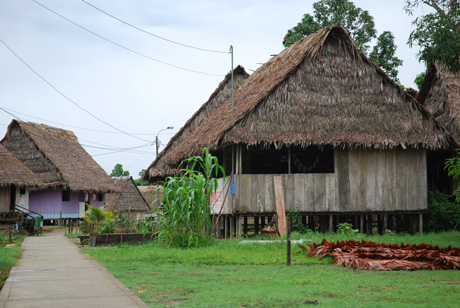
Buena Vista. (Photo: David Hill)
But one of O’s two workers, whom I will call “J,” was happy to talk.
“Yes, they’re there,” he told me, one morning, after I had speculated how dangerous his job as a logger must be: the rainforest, the wild animals, the no contactados.
He told me he had seen them, once, four months before. “Groups of them.”
What happened? “Nothing. All very calm. We looked at them and they looked back at us.”
What were they wearing? No clothes, but they had bracelets, feathers in their noses, red paint under their eyes, and something around their private parts.
I said I had heard that some people in Buena Vista now claimed they didn’t exist. He shook his head and said that was because they “didn’t want foreigners coming to try and find them.”
J continued upriver and left me in Buena Vista, where I spent almost a week. Evidence of Perenco and Repsol-YPF was everywhere: launches and speedboats going up and down the river, orange jumpsuits hanging on washing lines, helicopters overhead, announcements on the village radio about meetings with company personnel and thank-you’s to Perenco, Lego given to the children by Repsol-YPF, sweets and mineral water handed out after church. In one house, there was even a DVD of “Night at the Museum: Battle of the Smithsonian,” which had been given to the family living there, according to the head of the family, by Repsol-YPF’s community relations officer. This was eery: Repsol-YPF had given the Smithsonian Institution $635,000 to work in Lot 39, according to The Washington Times, and has used this connection to defend its activities there.
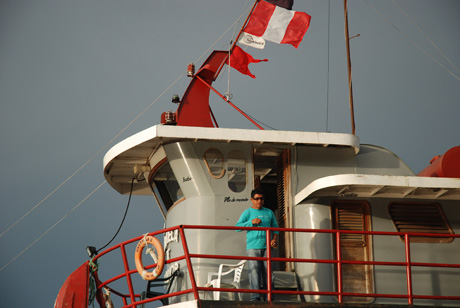
Repsol-YPF Boat on Napo-River. (Photo: David Hill)
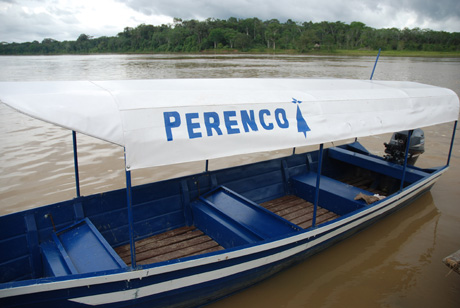
Perenco boat on the Curaray River. (Photo: David Hill)
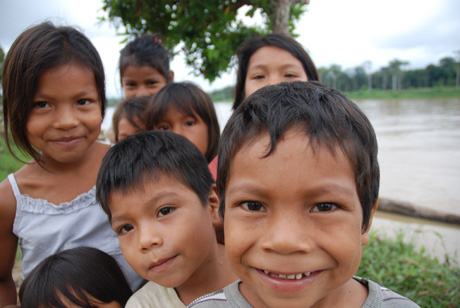
Kichwa children. (Photo: David Hill)
Sometimes in Buena Vista, the no contactados came up in conversation without me having to mention them. Over lunch one day, my host, Victoria, mentioned a German evangelical missionary, Christian, who had recently built a house in the village.
“He’s here to find the Arabelas malas,” she said – literally, the “bad Arabelas.” Buena Vista was officially an indigenous Arabela village, but many of its residents were mestizos.
Who did she mean? “The people who live hidden, further upriver.”
“The no contactados!” her husband chimed in, his mouth full of plantains.
Others in Buena Vista said the same. One evening on the village’s main drag, standing around a blaring television, I got talking to an old man, Modesto, who had lived there for years. He was calm until I asked about the no contactados.
“There aren’t any, mister!” he cried, suddenly very agitated. “We’ve got to work with the company!”
He gestured how the seismic lines and the no contactados were in different places.
“This is where the seismic lines are,” he said, “and the no contactados are here over the border with Ecuador.”
He called them the “no adoptados, the people we don’t know much about.”
Then he mentioned the missionary. “He’s come here to look for them, to talk to them, to teach them.”
Back in Iquitos, I tried to meet Montoya again, but I was told she was still away and to ring back. This was becoming the story of my life. What to do? First, find the missionary. Second, track down the 22 people listed as contributors to Daimi’s research and 2008 report. If Montoya wouldn’t blow the whistle, maybe someone else would?
Finding a missionary named Christian in a city of several hundred thousand people wasn’t easy, but eventually, after knocking on random church doors, I found someone who knew someone who knew him and could direct me to his church. Within minutes, I had found out his full name and was speaking to his wife on the phone. She invited me to dinner. Christian mentioned the no contactados before I did, after asking about Buena Vista.
“There are petrol companies up there. There’s another tribe up there. I was looking for them … I want to give them the chance to receive the Gospel,” he told me in excellent English.
He was due to travel to Buena Vista very soon. To look for the no contactados? “Yes.”
Had the people there ever spoken to him about them? He nodded, as if to say, “Many times.”
What did they say? “Years ago, they said they were there. Now, it’s not convenient for them.”
What did Perenco and Repsol-YPF think of his work? “They don’t like it.”
Christian said how easily rumors could spread in Buena Vista, and how many there had been about him – for example, that he was “selling information to NGOs.”
Information about what? “About the tribe above.”
The three lead authors of Daimi’s report were almost all equally candid. First I spoke to Grandez, the UNAP anthropologist who had gone into the field with Daimi and had been quoted by The Guardian two years before.
“We found evidence of their existence,” Grandez told me in his UNAP office. “There were signs. We never said there weren’t any.”
Grandez said that, in the most remote village in the region, just upriver from Buena Vista, he had heard how one man, Alejandro, had seen the no contactados – one woman and two children – and had returned home, scared, to tell his wife. Grandez wanted to hear this from Alejandro firsthand, so he visited his house, but he was away, working, and only his wife was in.
“It was nine o’clock at night,” Grandez told me. “I called out to her once, twice, three times, and when she opened the door, she asked me what I wanted. I told her. She invited me in, lit a candle, and we began to talk. Her husband had been upriver, she said, and saw several people, all naked, gathering suri grubs.”
Did he tell Daimi? Yes, he said, he told Daimi representative Violeta Chamorro, but it didn’t appear in the report. There was even more evidence than this, he said, but he didn’t have it on hand.
Grandez was especially critical of how little time he had to investigate: five days upriver from Buena Vista, more or less. “It was all so quick. More studies need to be done. For us, as professional anthropologists, it wasn’t satisfactory.”
Did Daimi deliberately conceal the no contactados‘ existence? Grandez chuckled and said, “They’ve come to the conclusion that suits them.”
While we were talking, another of the cited lead authors of Daimi’s report entered the office. This was Rosa Aguilera Rios, another UNAP anthropologist, who hadn’t gone into the field with Grandez but had read a “draft report” about their findings. What did the draft say?
“That some signs of their existence were found,” Aguilera replied.
I remarked that Daimí’s 2008 report claimed no evidence was found. Aguilera appeared to be unaware of this, pulled a shocked face and appealed to Grandez, on her right, for confirmation.
“Of course,” he said.
“You can’t say there isn’t any evidence for their existence,” said Aguilera, who had visited the Napo-Tigre region years before, “because there is evidence. There are people all over that area who have seen them, who talk about them.”
Did she think there are no contactados there? “Of course.”
She said the man to speak to about the draft was Jose Moscoso Conde, another lead author, another UNAP anthropologist who had gone into the field and shared the same office.
“We didn’t see them ourselves, but we found signs,” Moscoso told me. “We heard about one sighting and saw broken arrows and cut branches.”
He talked in detail about the sighting: how one local man had seen “two people, naked, about 200-300 meters away, a long way away. They realized a mestizo was watching them and fled.”
Moscoso said this sighting, along with information about a path or track, camps or fire remains believed to belong to the no contactados, was included in a paper copy draft which he, together with Grandez, signed but which now he didn’t have. When I told him Daimi’s report claimed no evidence at all was found, he seemed extremely surprised, like Aguilera.
“Our intention was to sound an alert so an area could be created for the no contactados which the companies couldn’t enter,” Moscoso said.
It was extraordinary: all three lead authors were saying the precise opposite of what Daimi’s report claimed. Did other contributors feel the same? Some were in Iquitos, some Lima, others elsewhere. One, whom I will call “A,” who did not confirm whether I could use his name or not, informed me that the following evidence for the no contactados was found: “twisted leaves, tracks leading to the river, animal bones and feathers from birds hunted by them, small shacks recently built by them, footprints, fruits from wild trees recently eaten by them….”
A said he had been in Buena Vista and the village upriver, Flor de Coco, for a month, “talking to the Arabela about their uncontacted relatives,” then spent another month upriver from there, and then another month along another river. What happened to all this evidence?
“It was all given to Daimi,” he said. “We were left with nothing. The videos, photos, recordings … they have it all.”
What did he think of Daimi claiming no evidence was found?
“The final report was dressed up and presented as if no evidence was found in order not to cause any problems for the government … It makes no mention of what any of the local people told us. They deny it all. Yes, they say there aren’t any no contactados, but time will tell.
Which other contributors might confirm that evidence was found? Two people, independent of each other, suggested I speak to Haroldo Salazar Rossi, but Salazar, working for INDEPA, now part of the Culture Ministry, denied it.
“Nothing, nothing was found, no recent evidence, no evidence found,” he told me in his office in Peru’s National Museum in Lima, although he did point out that they had wanted to visit an area where no contactados were reported to have been seen but it was too far away.
Salazar didn’t deny their existence entirely. They had wanted to “do a good job,” he said, but there wasn’t enough time, meaning large areas weren’t visited at all. For example, Lot 39, which completely surrounds Lot 67. For example, the Pucacuro Reserve, a supposedly protected area. In short, Salazar’s conclusion was: “It can’t be said the no contactados don’t exist. You can’t say there are or there aren’t any.”
Linguist Rossana Arbaiza Gonzales, another of the listed contributors, said the same. She cancelled our meeting in Lima, but emailed this: “We only visited half of the places we were supposed to … Given that, we can neither confirm or deny the existence of isolated indigenous peoples in the areas we didn’t go to.”
But some of the listed contributors did deny their existence. “Fiction,” said archaeologist Ruben Wong Robles in his Lima office. “Total lies,” said Klever Oversluijs Quevedo in Iquitos. “No traces were found,” said anthropologist Felix Auqui Baygorrea via email from Cusco, although Auqui pointed out the Daimi team had entered the region after seismic tests had already been done. That is, the no contactados might have been scared out of the region before Daimi even got there.
Explaining such differences in opinion isn’t difficult. For people continuing to work for Perenco, or in the industry in general, or those who may want to do so in the future, admitting any evidence was found clearly isn’t in their interests. Or they may genuinely be unaware that any evidence was found: after all, different teams of people went to different places at different times. When I asked forestry engineer Peter del Risco Torres, who went into the field with Daimi but wasn’t listed in its report, about Virginia Montoya, he said he had never heard of her.
“Do you think it’s possible that someone found evidence, but you just didn’t know about it?” I asked Oversluijs, remarking that although he said no evidence had been found, others disagreed.
“Who said that?”
“Virginia Montoya.”
“She saw some footprints,” he said dismissively, as if that didn’t matter.
Montoya never saw me, though. I tricked my way into her Iquitos office, got her mobile number, and spoke to her. She told me if I flew from Iquitos to Lima, she would meet me. She didn’t. She didn’t answer her mobile again. I left messages for days running; I texted her; I emailed her: no reply. Not even visiting IIAP’s satellite office in Lima helped. There, an IIAP employee rang another number for Montoya and an assistant answered and promised he would ring back later, about four o’clock, with a time the next day, about noon, to meet Montoya. He never did so.
Why wouldn’t Montoya talk? Explaining that isn’t difficult either. Her employer, IIAP, is a Peruvian government institute within the Environment ministry, and the government is so determined to keep Perenco working in Lot 67, it has declared operations there a “national necessity.” Second, Montoya, in her IIAP role, is, or has been, working closely with INDEPA, another government institute, which has since done its own U-turn from its June 2007 position, and now claims there isn’t enough evidence to prove the no contactados exist, after all. Third, IIAP signed a deal earlier this year with – guess who – Perenco, the stated aim of which is to carry out “biodiversity studies, cultural salvage work, and strengthening of productive activities” in the Lot 67 region.
Not that Montoya was the likeliest to speak out anyway, if her past record is anything to go by. Back in 2003, AIDESEP slammed a report of hers about Peru’s biggest gas fields where other no contactados were in danger, describing her as being “extremely well known” for being on the side of oil and gas companies and “bolstering the argument that our isolated brothers don’t exist so that oil and gas activities can continue happening.”[18] Sound familiar? AIDESEP was so angered by this report, it declared her co-author, Juan Ossio, persona non grata in the Amazon [19], which is ironic given that Ossio was Peru’s culture minister, the titular head of INDEPA, and has been under fire again in recent weeks after revealing new plans making it easier for oil and gas companies to operate on no contactados‘ land elsewhere in Peru.
A coverup has taken place: none of the evidence found by Grandez, Moscoso, A or Montoya found its way into Daimi’s report.
Neither did Montoya’s own name. Who else was omitted, and what might they know?
I visited Daimi’s office in Iquitos to ask such questions, but they had moved on. Punching their name into Google revealed a (spoof?) Facebook account, with a profile photo of a man wearing a balaclava and clutching a laptop and a wad of US dollars.

Daimi’s old office, Iquitos. (Photo: David Hill)
Currently, Perenco is gearing up to build a more than 200 kilometer pipeline right through the Napo-Tigre region, while Repsol-YPF has recently acquired a new partner in Lot 39, PetroVietnam, after ConocoPhillips sold its stake. Now that this cover-up has been exposed, there should be no delay in aborting any such pipeline plans or further exploration and leaving some of Peru’s most vulnerable citizens, some of the world’s last “uncontacted” people, to live in peace.
If that doesn’t happen, they could be wiped out.
Chamorro and IIAP’s president, Luis Campos Baca, did not respond to questions about their work in Lot 67.
1. Estudio Técnico: Delimitación Territorial a favor de los pueblos indígenas en situación de Aislamiento Voluntario ubicados en la Cuenca Alta de los Rios Curaray, Napo, Arabela, Nashino, Pucacuro, Tigre y Afluentes, AIDESEP, 2005.
3. Letter to Survival International, 17 May 2007.
4. Letter to the Energy Ministry, 29 March 2007.
5. Informe Defensorial 101: Pueblos indígenas en situación de aislamiento voluntario y contacto inicial, Defensoria del Pueblo, 2006.
6. Letter to the Energy Ministry, 5 June 2007.
7. Plan de Medidas Cautelares a favor de los Pueblos Taromenani y Tagaeri, presented to the Inter-American Commission on Human Rights, 2007.
8. Resumen del Seminario Taller: Promocion de la Actividad de Hidrocarburos en Comunidades Indígenas, 2003.
9. Plan de Contingencia para pueblos indígenas en aislamiento voluntario y/o no contactados, Repsol-YPF, 10 July 2007.
10. Plan de Contingencias Antropólogico para Pueblos Indígenas Indígenas en Aislamiento Voluntario, Barrett Resources, 2007.
11. Estudio de Impacto Ambiental de la Prospección Sísmica 3D del Lote 67, Barrett Resources, 2007.
12. Statement by the Energy Ministry, 17 December 2006.
13. Estudio Técnico: Delimitación Territorial a favor de los pueblos indígenas en situación de Aislamiento Voluntario ubicados en la Cuenca Alta de los Rios Curaray, Napo, Arabela, Nashino, Pucacuro, Tigre y Afluentes, AIDESEP, 2005.
14. Estudio Técnico: Delimitación Territorial a favor de los pueblos indígenas en situación de Aislamiento Voluntario ubicados en la Cuenca Alta de los Rios Curaray, Napo, Arabela, Nashino, Pucacuro, Tigre y Afluentes, AIDESEP, 2005.
15. Fortalecimiento de la Propuesta de Creacion de la Reserva Territorial Napo-Tigre, ORPIO, 2009.
16. Rapid Biological Inventories, 18, Nanay-Mazan-Arabela, The Field Museum, 2007.
17. Estudio Técnico: Delimitación Territorial a favor de los pueblos indígenas en situación de Aislamiento Voluntario ubicados en la Cuenca Alta de los Rios Curaray, Napo, Arabela, Nashino, Pucacuro, Tigre y Afluentes, AIDESEP, 2005. Fortalecimiento de la Propuesta de Creacion de la Reserva Territorial Napo-Tigre, ORPIO, 2009.
18. AIDESEP statement 1 July 2003.
19. Ibid. AIDESEP confirmed Ossio is still persona non grata, eight years later, in a recent statement.
Join us in defending the truth before it’s too late
The future of independent journalism is uncertain, and the consequences of losing it are too grave to ignore. To ensure Truthout remains safe, strong, and free, we need to raise $50,000 in the next 10 days. Every dollar raised goes directly toward the costs of producing news you can trust.
Please give what you can — because by supporting us with a tax-deductible donation, you’re not just preserving a source of news, you’re helping to safeguard what’s left of our democracy.
